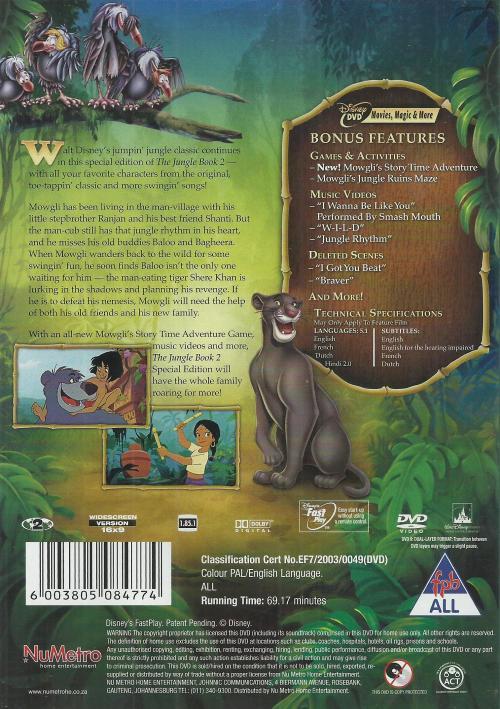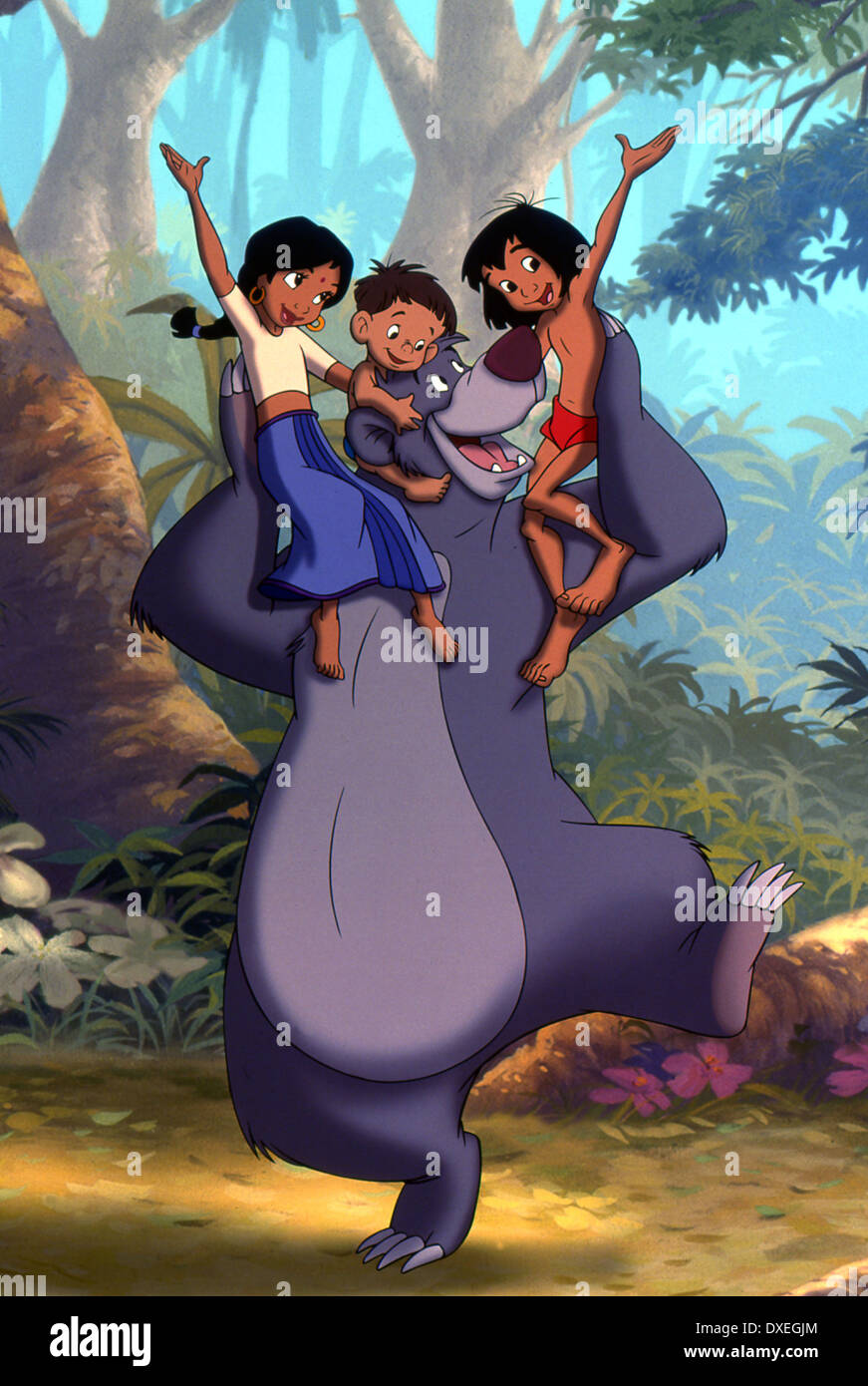Jungle Book 2 Mowgli
Critic Reviews of 'The Jungle Book: Mowgli's Story' Common Sense Media. August 27, 2013. Clunky jungle sequel has loss of parent and some peril. 'The Jungle Book 2' is the exact definition of why some sequels do not ever need to be made. This was at the time when Pixar and Disney's Animated Studios were making great films, so the fact that.
After being charmed by the village girl Shanti at the end of the last movie, Mowgli has since been accepted by the Man Village. Despite being adopted by a loving family, Mowgli still finds himself yearning for his old life in the jungle before he had to follow the rules of his new parents. Baloo has also found himself missing Mowgli and decides to pay him a visit despite Bagheera's objections. When Shanti mistakes Baloo for a wild predator, he and Mowgli run off to resume their carefree life in the jungle. Worried about Mowgli's well-being, Shanti and Mowgli's adopted brother Ranjan try to find him before anything happens to him.
Unbeknownst to Mowgli and his friends, Shere Khan has returned to the jungle, seeking revenge after his humiliating defeat at Mowgli's hands. Tropes related to The Jungle Book 2:.: Goes to ridiculous extremes when both Shanti and Ranjan, who unlike Mowgli have not grown up in the jungle, also automatically understand the animals with no explanation.:. Very noticeable between the two movies. The character designs are mostly the same, but they move slightly differently (most notably Mowgli, who is a lot more agile and often sports some animal-like movements he completely lacked in the original), the 'hard scratchy outline' look from the original is replaced with the softer lines of modern Disney movies, and the jungle is overall a lot more lush and colorful. Less noticeable because the shift is gradual, but during the W-I-L-D song sequence, Baloo's color changes from his usual gray to a brighter blue, his nose even going from brown to blue during the song. According to the moviemakers, this temporary color change was done because this particular sequence was so filled with brightly-colored animals that Baloo with his gray fur seemed a little drab in comparison — and since Baloo was supposed to be the center of attention in that scene, they gave him a more eye-catching color.: Shanti wears a white kofta that opens her belly.

She also wears an ankle-length skirt that covers her belly button.: Shanti brainy and she has long black hairs.: Shere Khan refuses to believe Kaa when the latter truthfully tells him he has no idea where Mowgli is.:. Kaa's incompetence and cowardliness are greatly exaggerated to the point where he becomes something of a, whereas in the first film he was yet constantly unsuccessful, and his general fear of Shere Khan (the same as everyone else) is exaggerated to not being able to form full sentences around him. Shere Khan seemed to take the opposite extreme who, while still the greatest threat of the original film, was still somewhat and in tone. Bagheera's status is also exaggerated between films.:.
King Louie, despite his status and appearances in previous media such as and, does not appear in the sequel (allegedly due to fears of a lawsuit issued by Louis Prima's widow over caricature of his voice). Colonel Hathi's wife and all of the wolves.: Ranjan does such a number on Kaa that even Shanti (who he was previously trying to devour) thinks. Though he's one of the most important characters in both Kipling's book and in the original movie, he's barely involved in the plot and.: Lucky.: Funnily enough, Mowgli has absolutely no problem cheerfully admitting that Shanti seduced him into the village, but she apparently finds it embarrassing.: You can see Ranjan's buttcrack during the wedgie scene if paused at the right frames.: Human example. Mowgli is called that (or Man-Cub) throughout the first movie by all the animals. Here, we see that his adopted human family has also named him Mowgli. It's also possible Mowgli either told them his name or he pretended to choose his own name. He can clearly communicate with them after all.: Mowgli and Ranjan's standard outfits.: Applies to Ranjan's loin cloth. The mummy games.
Similar to Mowgli's in the original Jungle Book, Ranjan's loin cloth is able to stretch a fair distance away from him and still remain intact after the fact.: The big dance number has both hippos and Thompsons gazelles (native to Africa) Kookaburras (native to Australia), Black sifaka lemurs (native to Madagascar) and ocelots (South and Central America).: When Shere Khan interrogates Kaa on Mowgli's whereabouts. He believes that Kaa knows where Mowgli is (after hearing the snake grumble 'man-cub').
But truthfully, Kaa has no idea where Mowgli is, but Shere Khan won't believe him and continues to threaten the snake. So to save his skin, Kaa fearfully lies to the tiger that Mowgli's at the swamp, allowing him to flee. When Shere Khan arrives at the swamp with Mowgli nowhere to be found, he angrily growls 'That snake lied to me!'
.: Implied with the heckling vulture Lucky. Shere Khan:.: An obscure foreign-language novelization rendered the village girl's name as. Obviously this wouldn't fly, so the movie and subsequent merchandise and press material for the first film gave her a different name.: Tony Jay, who provided the voice of Shere Khan, previously voiced a different variation of this character on The Jungle Book spin-off.: Shere Khan is, though still plays around with this at times.: Shere Khan seems to have grown a skill for these (most notably before he ).: 'W-I-L-D'.: Shanti says 'Tigers don't come into the village' and later in the film, Shere Khan does that exact thing.: When Shere Khan is interrogating Kaa on Mowgli's whereabouts. Shere Khan: Oh, please don't insult my intelligence.
It makes me irritable.: Lucky is a brainless (well, screwy vulture) who spends the majority of his role taunting Shere Khan over his defeat at the hands of Mowgli as up close as possible inadvertently giving him directions to the mancub's location in the process (before falling victim to a rather nasty beating).: Mowgli thankfully gets more capable in the sequel.: How Ranjan's hirsute, obese and middle-aged dad ever ended up with his very attractive young wife is a mystery note Considering that they are in India, is a likely answer. Partly justified in that he's an of his voice actor, John Rhys-Davies. Once with Baloo as he is walking inside the temple. 'Step aside and I'll show you what a real rug cutter can do'. Again with Baloo during the song WILD.

Does it after he knocks off look-alikes. Wedgie: Ranjan is the victim of this.
After Shanti tells him to stay and runs after Mowgli and Shere Khan, Ranjan almost immediately begins to follow her only for his shorts to get stuck on a branch and fling him backwards into Baloo.
Every week, new original films debut on Netflix and other streaming services, often to much less fanfare than their big-screen counterparts. Is Vox’s series highlighting the most notable of these premieres, in an ongoing effort to keep interesting and easily accessible new films on your radar. Mowgli: Legend of the Jungle The premise: The umpteenth cinematic retelling of Rudyard Kipling’s The Jungle Book, this -directed venture follows on the heels of of Mowgli , a young foundling who is raised by jungle animals, learns to speak to them, and wrestles with the divide between his humanity and his animal nature — to say nothing of a ferocious tiger named Shere Khan. Vox-mark vox-mark vox-mark vox-mark vox-mark What it’s about: There’s a reason people keep adapting The Jungle Book — it’s fun to see a little kid run around with big animals, and Kipling’s characterization of paternal Bagheera the panther , bumbling Baloo the bear (Serkis), and whispering python Kaa , along with many other animals, has stood the test of time. Strip away the book’s colonialist tendencies, which are much harder to stomach in post-colonialist 2018, and you’ve still got a kid, some animals, and a lesson about accepting your responsibilities as you grow toward adulthood. This particular adaptation has sat on the shelf for years and years — Netflix actually, which was happy to write off an expensive boondoggle —partially thanks to the success of Disney’s 2016 Jungle Book film, which won an Oscar for its visual effects and made loads of money at the box office.
Technically went into production before the 2016 Jungle Book, but its effects — which rely heavily on motion-capture performances, where human actors wear special gadgetry that allows their movements and facial expressions to translate to the computerized animals onscreen — took more time to finish. (The production process of this film.) Surely Serkis, an acknowledged master of motion capture, who created the roles of Gollum in The Lord of the Rings and Caesar in the, would use his considerable talent to create a film that. Netflix Well, that’s an isolated shot from. Netflix They can’t have tried to paste human faces and expressions onto animals, right? They wouldn’t have. It would be so. Netflix Okay.
I don’t like. It’s really making me uncomfortable. Netflix AHHHHHHHHHHHHHH!!!!!!!!! Netflix PLEASE MAKE IT STOPPPPP!!!! Netflix IT’S BAD. IT’S BAD, AND I DON’T LIKE IT!
Youtube The Jungle Book Part 10
Netflix Look: Before you even get to Mowgli’s story (which does some interesting things — especially with its attempts to center Mowgli’s experiences and dissect colonialism via a British dude played by, who just shows up two-thirds of the way through the movie — but is also surprisingly dark and cluttered, with no clear throughline), you have to wade through a whole bunch of effects that feel. Abandoned before they were fully baked. Motion capture is a great way to achieve certain effects. But it turns out when you use it to graft human expressions onto animals, you end up with the first movie to star.